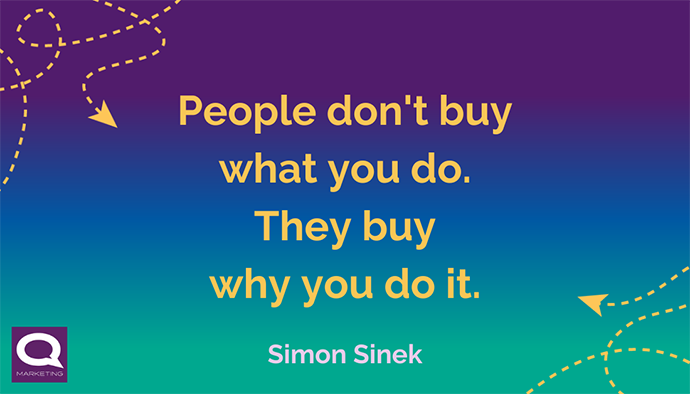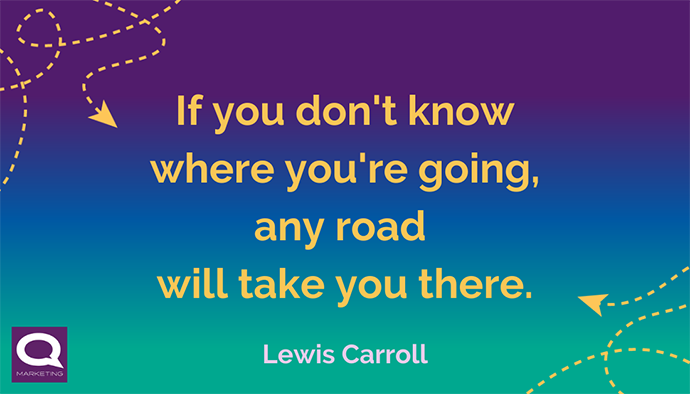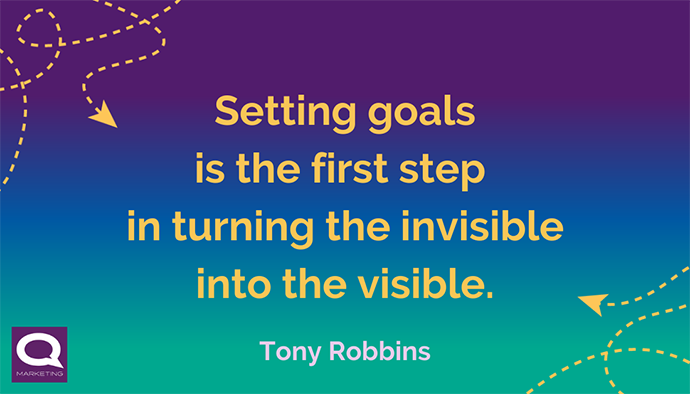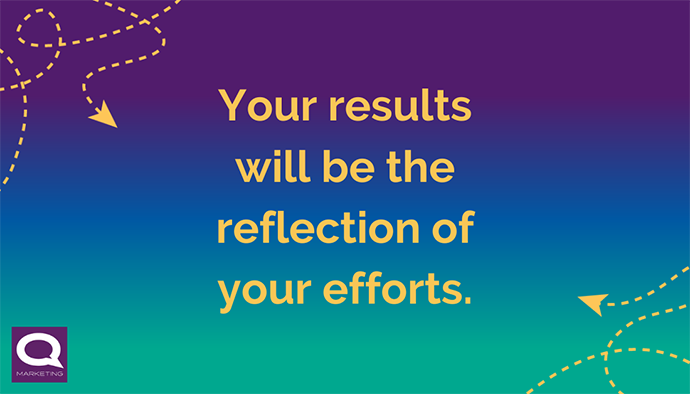Whether you’re starting a new business or you have an existing one, you need marketing to keep it top of mind with your customers and prospects. But with everything you have to deal with as a business owner, just the thought of creating a marketing plan can feel overwhelming. Many business owners I’ve met tend to fly by the seat of their pants when it comes to marketing, trying random things and wondering why nothing seems to work.
So where do you begin?
What should you focus on?
How will you know that your marketing is actually working?
This guide will walk you through the process of creating a strategic marketing plan that’s designed to achieve your goals and help your business grow.
Will it take time to put this together? Yes. It’s important to take the time to really think this through on the front-end. When you do, the reward will be a focused plan that takes the guesswork out of what you should be doing with your marketing. And going forward, you’ll just need to update your plan rather than doing the whole thing over again.
One thing to keep in mind: a good marketing plan is designed to be flexible. Things can change and new opportunities can come up that you weren’t expecting. It’s ok to make adjustments as you go along, as long as they support your goals.
This marketing plan guide has 5 sections:
- The Situation
- Goals
- Action Plan (Strategies and Tactics)
- Marketing Promotion Methods
- Results
Let’s go over each one.
The Situation
In the Situation section, you’ll need to do some research and answer some important questions. Take the time to think this through if you haven’t done so already in your business plan. It will help you get clear on your business and how you serve your customers so you can reach the right people with the right messages. Be sure to write your answers down, keeping in mind the saying, “what gets written gets done.”
Your Product or Service
Describe your product or service. Also think about the intangibles you provide. For example, a mattress store isn’t just selling a mattress, they’re selling a good night’s sleep. A home alarm business isn’t just selling an alarm system, they’re selling peace of mind and keeping your family safe. This will also help you with your branding and messaging.
- What product(s) or service(s) do you offer?
- How does your business help people solve a problem?
- How does your product or service provide value to your customer?
- What are the intangibles related to your product or service?
 Your Mission
Your Mission
If you’ve written a business plan, chances are you have a mission statement, so you can include it here. If you’re wondering what a mission statement is, I like this explanation from the book Business Made Simple by Donald Miller:
“You need a mission statement because it defines what you’re doing in an organization…A good mission statement is short, interesting, and inspirational. Otherwise it’s worthless. Your mission statement should explain what you are doing to serve people and why that effort matters.
People are attracted to a mission. They aren’t attracted to business jargon. Your business is made up of people who are looking to contribute to a mission.”
Miller created this formula to write a good, short mission statement:
We will accomplish _____ by _____ because of _____.
Here are a couple of examples from the book:
A software company: our software will run on half the computers in America by 2029 because nobody should have to suffer a software interface that confuses them.
A family restaurant: We will be known as the best pizza in the state within five years because people in our community deserve to brag about pizza made with local ingredients
Miller points out that mission statements like these inspire action and because they include a deadline, it also creates a sense of urgency. Once the deadline is reached, you just rewrite the mission statement.
Jot down your answers to these questions to have a basis for a mission statement:
- What does your business do?
- Who do you do it for (target market)?
- Why does your business exist – what is its purpose?
- What are you trying to accomplish?
Your Vision
What’s nice about the mission statement approach above is that it incorporates a vision and clearly defines what you’re trying to accomplish. But you could always go with a more traditional approach and have separate mission and vision statements. (They are not interchangeable). BPlans.com explains a vision statement this way:
“A vision statement is exactly what it sounds like. It’s a vision for the direction of your company and what it aspires to be.
…it is meant to be something that you’re pushing yourself, and your business, to achieve.
Your mission statement should serve as the roadmap to achieve your vision statement. And your vision statement should serve as the guiding light for the aspirations of your business.”
Some questions to consider as you determine your vision:
- Where do you see your business in the future (3-5 years)?
- What aspirations do you have for your business?
- What business are you striving to build?
- How will your business make people’s lives better?
Your Target Customer
It’s important to define who your target customer is. It’s not a good strategy to try to appeal to everyone. Defining your target customer will help you determine your messaging and where you should be promoting your business. Here are some questions to start with:
- Who is your target customer*?
- Why does he/she need your product or service – what are the problem(s) they’re trying to solve and how does your business help solve their problem?
*When defining your target customer, it’s a good idea to create a customer “persona.” According to marketing expert Neil Patel, a customer (or marketing) persona is:
“a fictional person that fits centrally into one of your target audiences because they share the most common characteristics of your customers.
But they are not just a pile of demographic information like age and income level.
A marketing persona is more like a character in a book. They have passions, strengths, and flaws.”
When creating your customer persona, you can include such info as first name, gender, interests, social media they follow, education level, profession, number of children, marital status, brands they like, hobbies, activities they like, influencers they follow, content they like, demographic info, etc.
This persona will serve as a guide when you’re creating content or posting on social media since you be able to envision the person you’re trying to reach. To learn more, check out Neil’s blog post on creating accurate customer personas for marketing.
Describe your Market
- Is it a geographical area? Include any key characteristics of the market that are relevant to your business and your marketing.
- Is your business solely online? If so, is it global, just focused on the U.S., or another country?
- A combination of both?
The Competition
Most businesses have competitors, even if your business is new. Pay attention to what your competition is doing, especially when it comes to marketing. How does your business compare? Here are some questions to help you evaluate the competition.
- Who are the top competitors in your market? (Name 1-5 and rank them. If you’re an established business, where does your business rank on this list?)
- What are their specialties?
- What products or services do they provide that your business does not?
- What products or services do you both provide in common?
- How long have they been in business?
- What marketing tactics do they do well (ex: social media, advertising, promotions, events, etc.) Be sure to screen-cap or save examples – they might lead to good ideas for your business.
- In what areas do they do a poor job?
- Have they announced any significant plans that could affect your business (expansion, renovation, new products, etc.)?
Going through this exercise will help you gain clarity on how your business stands out among the competition, and will help you determine what your value proposition is (see below). Plus you’ll also learn what you need to do to keep up with your competitors.
It helps to create a spreadsheet with this info so you can review everything at a glance.
Your Unique Selling Points (USP)
In what areas does your business stand out from the competition and why? This will help you determine your unique selling points. Here are some examples of areas in which your business may have an advantage over the competition:
- Product features and benefits
- Quality
- Reputation
- Experience
- Price
- Customer service / customer support
- Expert in the field
Your Value Proposition
Your Value Proposition makes it clear why someone would want to buy from your company instead of a competitor. Here’s a good explanation from HubSpot:
“Your value proposition is the core of your competitive advantage. It’s your unique identifier. Without it, people don’t have a reason to work with you over somebody else.
While your value prop should help differentiate you from the rest of the industry, keep in mind it’s not a slogan, tagline, or even a way to position yourself in the market.
Your value proposition goes deep into the problems you want to solve for people, and what makes you the right one for the job.”
— From “How to Write a Great Value Proposition [Infographic]”
Hubspot’s blog also gives the following steps to write your Value Proposition:
- Identify all the benefits your product offers.
- Describe what makes these benefits valuable.
- Identify your customer’s main problem (a.k.a., pain point).
- Connect this value to your buyer’s problem.
- Differentiate yourself as the preferred provider for this value.
A great value proposition can be the difference between losing a sale and closing it.
The HubSpot blog also features an infographic by QuickSprout which states that the value proposition should be the #1 thing visitors see on your page. It explains:
- How your product(s) solves problems/improves situations
- What specific benefits customers can expect
- Why customers should buy from you over your competitors
Here’s an example of a value proposition for UBER:
Tap the App, Get a Ride.
Uber is the smartest way to get around. One tap and a car comes directly to you. Your driver knows exactly where to go. And payment is completely cashless.
And one for InfusionSoft:
Small business sales and marketing software
Get organized. Grow sales. Save time.
What are your challenges?
What are the challenges your business is facing in the coming year? (You might have already done this exercise as part of your business plan). Making a list can help you determine whether you can address these challenges with marketing goals and strategies.
Some examples include:
- New to the market – need to build awareness of the business
- Increasing competition
- Need to get more sales from existing customers and attract new customers
- Small budget for marketing – need to find cost-efficient ways to advertise and promote
- Need to promote new services or products
- The pandemic has caused major changes to the business – need to pivot
If you have an established business, consider doing a S.W.O.T. analysis of your Strengths, Weaknesses, Opportunities, and Threats. Typically, this is part of the business plan process and is very helpful in determining what strategies to focus on. Check out this very good post on “How to do a SWOT Analysis,” from WordStream.
Other questions to answer:
- Have you had any significant changes to the business or the market in the past year?
- Are you planning any significant changes to your business, such as a renovation?
- Are there any business milestones that should be addressed, such as an anniversary?
Your One-Liner
If you haven’t read “Marketing Made Simple” by Donald Miller and Dr. J.J. Peterson, be sure to pick up a copy. In the book, Miller discusses creating a “One-Liner,” which is designed to associate your brand or service with a solution to your customer’s problem. It’s the perfect exercise to get clear on what your business does and how it helps people in a concise and understandable way. It can also serve as your value proposition.
Your one-liner should have 3 parts: the problem, the solution, and the result.
Here’s their example for a children’s dentist office:
The problem: Most parents get stressed when they think about taking their child to the dentist.
The solution: At Kids’ Teeth, our fun and welcoming office puts kids at ease.
The result: …so they aren’t afraid and their parents actually enjoy their dentist visit.
(The result clearly explains how your customer will feel and what they get after you solve their problem).
Put it all together:
Most parents get stressed when they think about taking their child to the dentist. At Kids’ Teeth, our fun and welcoming office puts kids at ease so they aren’t afraid and their parents actually enjoy their dentist visit.
You can include your One-Liner on your website homepage, in marketing materials, in ads, etc., and it even works at networking events.
The book goes into more detail on how to use a one-liner with more examples.
Define Your Brand
Once you have gone through the sections above, you’ll be ready to define your brand. While this is a big topic that is better suited for another blog post, here are some basics to consider if you haven’t already addressed branding for your business or if you’re considering a rebrand.
So what is branding? I like this definition from a post by Entrepreneur:
“Simply put, your brand is your promise to your customer. It tells them what they can expect from your products and services, and it differentiates your offering from your competitors’. Your brand is derived from who you are, who you want to be and who people perceive you to be.”
According to Entrepreneur, when defining your brand, some of the questions you should answer include:
- What is your company’s mission?
- What are the benefits and features of your products or services?
- What do your customers and prospects already think of your company?
- What qualities do you want them to associate with your company?
A couple more that I think should be included:
- How does your business help people?
- What is your value proposition?
- What are your key message points?
The good news is if you have completed the Situation section of your marketing plan, you have already answered these questions.
Ideally, it’s best to work with a designer when creating brand materials. However, if budget is an issue, and you have the skills, there are many platforms to help you do this yourself.
When meeting with a designer for the first time, it’s helpful to bring:
- Examples of logo styles you like
- Examples of campaign styles you like (colors, designs, fonts)
- Words that describe your brand
- The Situation section of your marketing plan
With this information, the designer will then be prepared to provide you with a visual identity which includes a logo, color palette, artwork, and brand guidelines. Your brand messaging should also include a tagline, tone of voice and brand values. For a better idea of how a graphic designer would work with you on a branding or rebranding project, check out this post from Shields Design Studio.
S.M.A.R.T. Goals
Now that you have established your situation and clarified what your business is about, it’s time to set some marketing goals.
You’ve probably heard of S.M.A.R.T. goals, but let’s review them briefly here so you can use this as a guide for setting your goals:
Specific: Is the goal well-defined? Does it align with your overall business objectives?
Measurable: Is the goal measurable? How do you define success?
Attainable: Is achieving this goal possible based on where you are now?
Realistic: Does this goal fit with overall business objectives in a scalable and manageable way, while still being ambitious?
Time-Bound: What is the timeframe of this goal (or what is the due date)?
The goals in your marketing plan should support your overall business objectives. In other words, you should have a set of higher-level goals (e.g, sales, operations, etc.) that are addressed in your business plan, but the goals in your marketing plan should be marketing oriented.
So for example, say you have a business goal to reach $100,000 in sales by the end of the year. You could have a related marketing goal to increase website traffic and e-commerce sales by 20% by year end. Then you would create a marketing strategy to accomplish this goal.
Other examples of marketing goals:
- Start a blog on our website and secure at least 1,000 subscribers by Dec. 31st.
- Increase total website sessions (visits) by 15% over last year – from 100,000 in 2020 to 115,000 in 2021.
- Generate publicity for the business with at least one published article or podcast interview per quarter.
- Gain 500 followers on Instagram, LinkedIn, and Facebook by June 30th.
I usually have between 4-6 goals in a marketing plan. Be careful not to have too many goals as this can be overwhelming. Consider your resources – is it just you that will be working on these goals or do you have help? Prioritize your goals and include the most important ones that you can accomplish.
The Action Plan – where you put the pedal to the metal
Strategies & Tactics
Sometimes people get strategies and tactics confused, so here’s a definition of each.
A strategy addresses a goal and defines how it will be accomplished. It’s more of a general statement rather than a specific to-do list. Here’s an example:
Goal: Start a blog on our website and secure at least 1,000 subscribers by Dec. 31st.
Strategy: Create a blog with content that addresses problems our target customers are experiencing with how-to articles. Also feature educational content such as interesting trends and products. Generate awareness of the blog and encourage people to subscribe to our email list.
Tactics are the specific steps (or to-do list) that support your strategy. Here are some tactics examples for the strategy above:
- Create a list of 24 blog topic ideas and devise a bi-weekly posting schedule.
- Send a survey to our customers to help determine blog topic ideas.
- Keep a list of questions we receive from customers.
- Do Google searches on topics to see what related terms people are searching for.
- Create a checklist for writing a blog.
- Set up the blog on the website.
- Send a link to the blog via email to the subscriber list.
- Share finished blogs on social media channels (Facebook, LinkedIn, Twitter, Instagram).
- Encourage social media followers to subscribe to the blog.
- Include a sign-up link to the blog in the blog itself.
- Include social share buttons on the blog to make it easier for readers to share it.
- Track subscriber sign-ups, open rates, link clicks, unsubscribes, etc. for the blog emails.
- Track traffic to the blog on Google Analytics.
You should create strategies and tactics for each of your goals.
Typically, the timeframe for a marketing plan would be a year. Each year you will review it and make adjustments to the situation, goals, strategies, and tactics, depending on your results and how your situation changes (and it definitely will).
I also find it very helpful to create a quarterly to-do list in Excel with due dates and notes. This makes it easier to keep track of the list of tactics for each goal throughout the year. Or you can use a platform like Asana or CoSchedule.
It’s also a good idea to include a calendar in your marketing plan with dates marked off for promotions, events, advertising campaigns, blogs or newsletters, etc. If you’re super-organized, include the due dates from the to-do list and set up reminders.
Marketing Promotion Methods:
Your marketing plan should address how you will promote your business and engage with your customers and your target audience. Here are a few basics to include.
Social Media Plan: Social media will likely be a big part of your marketing plan. To help guide you, it’s important to have a social media plan. When I do a social media strategic plan for clients, the sections I include are:
- Current status of each social platform being used (key metrics)
- Target audience(s)
- Tone of Voice (ex: friendly, funny, informative, straight-forward, etc.)
- Goals/strategies/tactics
- Key message points
- Post topic categories (ex: product demo, behind the scenes, how-to, inspirational quotes, upcoming events, etc.)
- Post formats (ex: newsfeed, stories, reels, etc.)
- Key dates
- Hashtags
Advertising Plan: In this section, you should address how you plan to advertise your business and when. This includes advertising on social media. Organize your plan by campaign:
Ad Campaign #1:
- Name of campaign
- Run dates
- Target audience
- Type of advertising (ex: social media, radio, direct mail, digital ads, Google ads, etc.)
- Media (i.e., what social platforms, radio stations, etc.)
- Key message points
- Budget
Do the same for all of your ad campaigns and plug them into your calendar.
PR Plan: How will you publicize your business? (Things you can publicize include company news, new hires, events, community activities, charities, partnerships, how-to articles, industry trends, etc.)
- Press release schedule
- Topics
- Media to target (create a media email list)
Email Marketing Plan: It’s wise to make the most of email marketing. Why? Because you own your subscriber list and can communicate directly with people who sign-up to hear from you. By contrast, you don’t own your Facebook or Instagram pages – if they disappear, you would lose all of your assets and followers. One of the focuses of your plan should be to build your subscriber list. You could make this a goal and tie-in strategies and tactics to support it (like the blog subscriber example I gave earlier). In this section, you should plan out:
- when you’ll send emails to your subscribers
- what the format will be (blog, newsletter, e-blast, etc.)
- topic(s)
- special offer or lead magnet* if you have one, etc
*A lead magnet is content considered to be high-value that a person would give their email address to subscribe to your email list to get the download. Examples are ebooks, how-to guides, checklists, first chapter of your new book, etc.
Website: Include any focus areas for your website over the next year. For example, do you plan to launch a new website or redesign an existing one? Will you be working with a designer or doing this yourself? Will you be adding new features like a blog, videos, lead magnets, etc.? Remember that your website is the “hub” of your online activity so don’t ignore it. It’s a good idea to have a goal related to your website such as increasing traffic.
Marketing Budget
Of course, your budget will dictate the extent of what you’ll be able to do with your marketing. Many of the tactics described earlier can be done for free, but try to allocate some dollars for advertising, producing marketing materials, fees for marketing platforms that you use, website expenses, promotions or event expenses, paying someone to help, etc. Use a spreadsheet to spread your expenses over the course of a year or use an online platform if you have one.
How much should you spend on marketing? If you’re just starting out, try to at least allocate some dollars for social media ads that will help you generate awareness and expand your reach. I’ve found that Facebook ads are very cost-effective, and Google ads can also be effective as well. When you run ads, pay close attention and test different formats to see what works for your business. Don’t waste your precious dollars on advertising formats that don’t reach your target customer.
If you’re an established business, the U.S. SBA recommends spending 6-7 percent of your gross revenue for marketing and advertising if your sales are less than $5 million and net profit (after expenses) is 10-12 percent.
Results
I mentioned that a marketing plan typically covers a year. At the end of the year, it’s important to analyze your results. This process will help you with your plan for next year as you will see what worked and what didn’t.
Here’s a list of items to include in your results analysis. You should also be tracking these items throughout the year to stay on top of how you’re doing.
Results for each goal: Did you accomplish them? Include notes on why or why not.
Website: Your website is the hub of all your internet activity and ideally your online efforts should drive traffic back to your website. So, it’s important to track your website analytics including sessions (visits), users (visitors), page views, time on site, new visits vs. return visits, referral traffic, page traffic, and more. I like to do this on a monthly basis so you can see how your traffic looks at different times of the year. Google Analytics is a must for your website, so if you don’t have that set up yet, put it at the top of your list.
Social Media: While you may have a specific goal for social media, it’s also a good idea to review the analytics for all of the platforms you’re active on. Facebook, LinkedIn, Instagram, Twitter, Google My Business, etc. all have analytics that you can find on their platforms, including top posts, reach, engagement, etc. If you subscribe to a posting platform like Hootsuite or Buffer, you can also get analytics reports from them for all your social media, however, there is usually a fee for this.
Email Marketing: Your email marketing platform also provides analytics. Be sure to track them if you’re actively sending email blogs or newsletters to subscribers.
Advertising Campaigns: If you ran online or social media ads, you should review the results analytics provided by the platform. Facebook provides excellent analytics for advertisers, and virtually all the online platforms like Google, and media websites provide analytics like reach, frequency, clicks, landing page views, and much more.
Sales Promotions: If you’re a retailer be sure to track the results of your sales promotions, and compare to last year if you’re an established business. Sales results, traffic counts, contest entries, email sign-ups, etc. are traditional things to track.
Publicity: If you secured publicity for your business, be sure to note the results of that as well. For example, if you were featured in an article on a media website, ask them for traffic data. Also refer to your Google Analytics to see if the article drove traffic to your website. Make a note on whether you received any customer feedback on the article or if you noticed an uptick in business.
Community Causes: If your business is involved in a community cause or with a non-profit organization, track results for any events you might have participated in, especially if they were hosted by your business. This includes publicity.
When you track the data that is available to you, you’ll have a better sense of how effective your marketing is, and this will make it easier to plan for next year.
Conclusion
As I mentioned earlier, putting a marketing plan together takes time, but once you’ve completed it, you’ll have a powerful roadmap for growing your business.
The end result is your marketing won’t have to be a guessing-game or a source of frustration, and you’ll be clear on what you need do to accomplish your goals.
I’ll soon introduce a workbook to support the steps in this blog, so stay tuned for that. If you haven’t already done so, sign up for my email list (form below) and you’ll be among the first to know when it’s ready.
Caroline D. Quinn is the founder of Quinnovative Marketing, a marketing services company based in Plymouth MA. She is focused on helping small and mid-size business owners in New England. You can follow Quinnovative on Facebook, Instagram, and LinkedIn.






